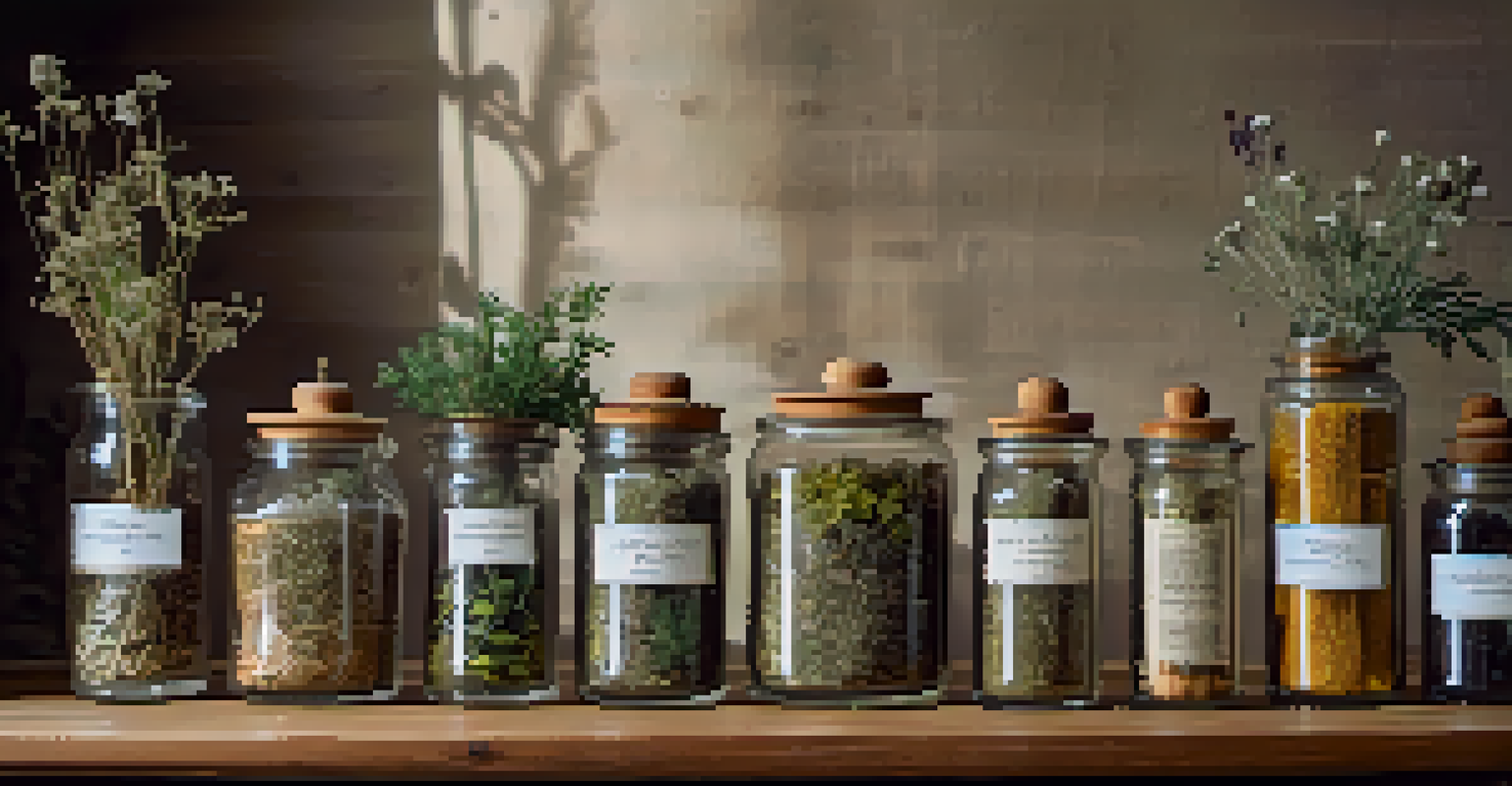The Effects of Climate Change on Medicinal Plant Species

Understanding Medicinal Plants and Their Importance
Medicinal plants have been a cornerstone of healthcare for centuries, providing natural remedies for various ailments. These plants are not only vital for traditional medicine but also contribute significantly to modern pharmaceuticals. For example, over 25% of modern medicines are derived from plants, underscoring their importance in our health systems.
The greatest threat to our planet is the belief that someone else will save it.
With the growing interest in herbal medicine, the demand for medicinal plants is increasing. This surge can lead to overharvesting and habitat destruction, which further complicates their sustainability. Understanding their ecological role is essential for preserving biodiversity and ensuring that these plants continue to thrive.
The interconnectedness of ecosystems means that the decline of medicinal plants could have ripple effects on human health. If we lose these valuable resources, we might lose potential cures and treatments that could benefit future generations.
How Climate Change Alters Plant Habitats
Climate change is causing significant shifts in weather patterns, which directly affect the habitats where medicinal plants grow. Rising temperatures and altered rainfall patterns can lead to changes in soil quality, making it harder for certain plants to flourish. For instance, drought conditions can restrict the growth of moisture-loving species, pushing them toward extinction.

Furthermore, as global temperatures rise, many plant species are forced to migrate to cooler areas. This shift can disrupt existing ecosystems and lead to competition with other native plants, impacting their survival. In some cases, the delicate balance of these ecosystems may be irreversibly altered, jeopardizing the plants that have been relied upon for generations.
Medicinal Plants Are Vital Resources
Medicinal plants are crucial for both traditional and modern medicine, with over 25% of contemporary medicines derived from them.
The loss of specific habitats not only threatens these plants but also the communities that depend on them for their health and livelihood. This makes understanding and mitigating climate change impacts crucial for preserving our natural medicine cabinet.
Effects of Temperature Changes on Plant Growth
Temperature plays a critical role in the growth and development of medicinal plants. Many species require specific temperature ranges to thrive, and even a slight increase can hinder their growth cycles. For example, plants that bloom too early due to warmer winters may face frost damage, which can reduce their populations.
In every walk with nature one receives far more than he seeks.
Moreover, higher temperatures can lead to increased susceptibility to pests and diseases. As plants become stressed from heat, they may be less able to fend off infestations, leading to a decline in their populations. This cycle can create a domino effect, impacting the availability of plant-based medicines.
Understanding the temperature tolerance of medicinal plants can help us identify which species are at risk and develop strategies for conservation. By protecting these plants, we can ensure that they continue to provide their invaluable benefits.
The Role of Water Availability in Plant Health
Water availability is another crucial factor that influences the health of medicinal plants. Climate change is altering precipitation patterns, leading to either excessive rainfall or prolonged droughts. Both extremes can be detrimental; too much water can cause root rot, while too little can lead to dehydration.
Some medicinal plants are particularly sensitive to changes in water availability. For instance, species like ginseng thrive in specific moisture conditions, and any deviation from this can affect their growth and medicinal properties. This not only impacts the plants themselves but also the people who rely on them for medicinal use.
Climate Change Threatens Plant Habitats
Rising temperatures and altered precipitation patterns due to climate change significantly disrupt the habitats essential for medicinal plants.
Managing water resources effectively is essential for the survival of these plants. By implementing sustainable practices, we can help ensure that medicinal plants have the water they need to flourish in an ever-changing climate.
Impact of Invasive Species on Native Medicinal Plants
As climate change alters habitats, it creates opportunities for invasive species to thrive, often at the expense of native plants. Invasive species can outcompete native medicinal plants for resources, leading to their decline or extinction. For example, non-native plants can alter soil chemistry and nutrient availability, disrupting the delicate balance of local ecosystems.
The introduction of these invaders can also lead to the spread of diseases and pests that native plants are ill-equipped to handle. This further jeopardizes the already vulnerable medicinal plant populations, making conservation efforts even more critical.
Efforts to manage invasive species and protect native habitats are essential for preserving the biodiversity of medicinal plants. By educating communities about the importance of local flora, we can foster a greater appreciation for these invaluable resources.
The Importance of Conservation Efforts
Conservation efforts play a vital role in protecting medicinal plant species from the adverse effects of climate change. By establishing protected areas, we can create safe havens for these plants to flourish without the pressures of habitat destruction and overharvesting. Furthermore, conservation programs can help restore degraded habitats, providing a second chance for endangered species.
In addition to protecting existing plants, conservation initiatives can also focus on cultivating these species in sustainable ways. By promoting responsible harvesting practices and encouraging cultivation, we can reduce the pressure on wild populations and ensure a steady supply of medicinal plants for future generations.
Conservation Efforts Are Essential
Conservation initiatives are vital to protect and sustain medicinal plants, ensuring their availability for future generations.
Collaborative efforts among governments, NGOs, and local communities are essential for the success of conservation programs. Together, we can work to safeguard the future of medicinal plants and their invaluable contributions to healthcare.
The Future of Medicinal Plants in a Changing World
The future of medicinal plants in the face of climate change is uncertain, but there is hope. With ongoing research and advancements in sustainable practices, we can mitigate some of the impacts affecting these vital species. Understanding the specific needs of medicinal plants will allow us to develop targeted conservation strategies that can help them adapt to changing conditions.
Moreover, public awareness and education about the importance of these plants can lead to greater support for conservation initiatives. As more people recognize the value of medicinal plants, we can foster a collective effort to protect and preserve them.

Ultimately, the survival of medicinal plants hinges on our actions today. By prioritizing their conservation, we can ensure that these natural treasures continue to thrive for generations to come.